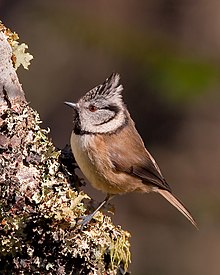Paridae
| Tits | |
|---|---|
 |
|
| European crested tit in Scotland | |
| Scientific classification | |
| Kingdom: | Animalia |
| Phylum: | Chordata |
| Class: | Aves |
| Order: | Passeriformes |
| Suborder: | Passeri |
| Family: |
Paridae Vigors, 1825 |
| Genera | |
|
5–10, see text. |
|
 |
|
| Global range (In green) | |
| Synonyms | |
|
see text |
|
5–10, see text.
see text
The tits, chickadees, and titmice constitute the Paridae, a large family of small passerine birds which occur mainly in the Northern Hemisphere and Africa. Most were formerly classified in the genus Parus.
While commonly referred to as "tits" throughout much of the English-speaking world, these birds are called either "chickadees" (onomatopoeic, derived from their distinctive "chick-a dee dee dee" alarm call) or "titmice" in North America. The name titmouse is recorded from the 14th century, composed of the Old English name for the bird, mase (Proto-Germanic *maison, German Meise), and tit, denoting something small. The spelling (formerly titmose) was influenced by mouse in the 16th century. Emigrants to New Zealand presumably identified some of the superficially similar birds of the genus Petroica of the family Petroicidae, the Australian robins, as members of the tit family, giving them the title tomtit, although, in fact, they are not related.
These birds are mainly small, stocky, woodland species with short, stout bills. Some have crests. They range in length from 10 to 22 cm. They are adaptable birds, with a mixed diet including seeds and insects. Many species live around human habitation and come readily to bird feeders for nuts or seed, and learn to take other foods.
With the exception of the three monotypic genera Sylviparus, Melanochlora, and Pseudopodoces, the tits are extremely similar in appearance, and have been described as "one of the most conservative avian families in terms of general morphology". The typical length of the family is between 10 and 16 cm (3.9 and 6.3 in) in length; when the monotypic genera are added, this range is from 9 to 21 cm (3.5 to 8.3 in). In weight, the family ranges from 5 to 49 g (0.18 to 1.73 oz), this contracts to 7 to 29 g (0.25 to 1.02 oz) when the three atypical genera are removed. The majority of the variation within the family comes in plumage, and particularly colour.
...
Wikipedia
